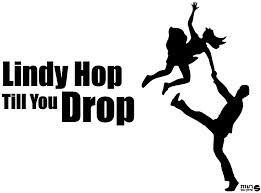The Lindy Hop was born in black communities in Harlem, New York, in the United States from about 1927 into the early 1930s from four possible sources: the breakaway, the Charleston, the Texas Tommy, and the hop.
One alleged source of the dance’s name is the famous aviator Charles Lindbergh, who was nicknamed “Lucky Lindy”. After Lindbergh’s solo non-stop flight from New York to Paris in 1927 he became incredibly popular and many people named businesses and other things after him.
The Lindy Hop was similar to the dance known as the Texas Tommy which became popular in New York in the 1910s. The basic steps in the Texas Tommy were followed by a breakaway identical to that found in the Lindy. The dancer “Shorty” George Snowden said that “We used to call the basic step the Hop long before Lindbergh did his hop across the Atlantic. It had been around a long time and some people began to call it the Lindbergh Hop after 1927, although it didn’t last. Then, during the marathon at Manhattan Casino, I got tired of the same old steps and cut loose with a breakaway.” According to Snowden, Fox Movietone News covered the dance and filmed a close-up of Shorty’s feet. He was apparently asked “What are you doing with your feet,” and he replied, “The Lindy”. The date was 1928.
The first generation of Lindy Hop is associated with dancers such as “Shorty” George Snowden, his partner Big Bea, and Leroy Stretch Jones and Little Bea. “Shorty” George and Big Bea regularly won contests at the Savoy Ballroom. Their dancing emphasized the difference in size with Big Bea towering over Shorty. These dancers specialized in floor steps.
As white people began going to Harlem to watch the black dancers, the “lindy-hoppers” at the Savoy began to practice acrobatic routines. Charles Buchanan, manager of the Savoy, began paying dancers such as Shorty Snowden to “perform”. When “Air steps” or “aerials” such as the Hip to Hip, Side Flip, and Over the Back (the names describe the motion of the woman in the air) began to appear in 1936, the old guard of dancers such as Leon James, Leroy Jones, and Shorty Snowden disapproved of the new moves.
Younger dancers fresh out of high school (Al Minns, Joe Daniels, Russell Williams, and Pepsi Bethel) worked out the Back Flip, “Over the head”, and “the Snatch”.
Frankie Manning was part of a new generation of Lindy Hoppers, and is the most celebrated Lindy Hopper in history. Al Minns and Pepsi Bethel, Leon James, and Norma Miller are also featured prominently in histories of Lindy Hop. Frankie Manning, working with his partner Freida Washington, Al Minns and Pepsi Bethel are generally credited for inventing the “Air Step” or “aerial” in 1935. An Air Step is a dance move in which at least one of the partners’ two feet leave the ground in a dramatic, acrobatic style done in time with the music.
Hop entered mainstream American culture in the 1930s. Dance troupes, including the Whitey’s Lindy Hoppers (also known as the Harlem Congaroos), Hot Chocolates and Big Apple Dancers exhibited the Lindy Hop. Hollywood films, such as Hellzapoppin’ and A Day at the Races began featuring the Lindy Hop in dance sequences. Dance studios such as those of Arthur Murray and Irene and Vernon Castle began teaching Lindy Hop. By the early 1940s the dance was known as “New Yorker” on the West Coast.
Lindy Hop moved internationally for the first time in the 1930s and 40s, thanks to films and news reels, but also with American troops stationed overseas, particularly in the United Kingdom, Canada, Australia, and New Zealand.
Arthur Murray’s 1954 edition of How to become a Good Dancer included four pages of instruction for Swing: the Basic Lindy Step, the Double Lindy Hop, the Triple Lindy Hop, the Sugar Foot Walk, and the Tuck-In Turn. A chapter is devoted to Lindy Hop in the 1953 and 1958 editions of Dancing Made Easy. The 1962 Ballroom Dancebook for Teachers included an entire chapter on “Lindy”. According to the book Social Dance, copyrighted in 1969, by 1960 The Lindy Hop was known as swing.
